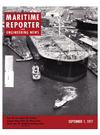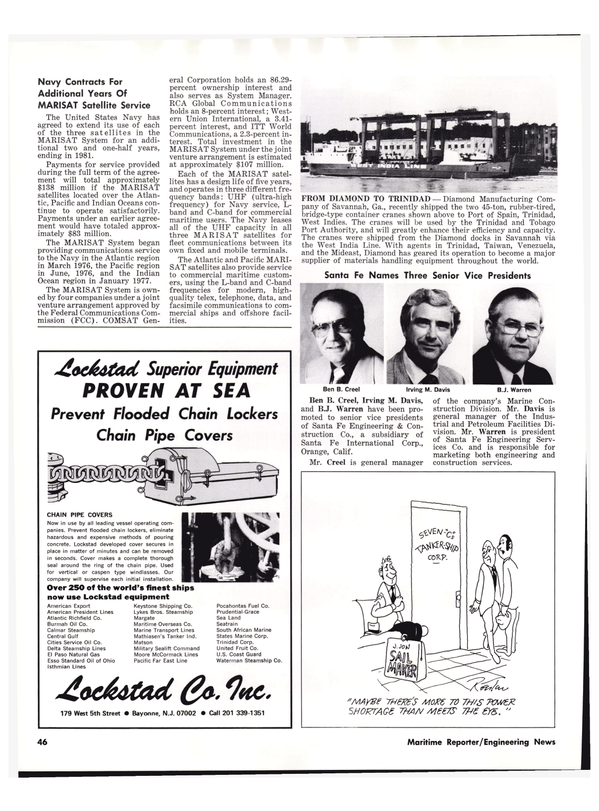
ITT Decca Marine Introduces 'Clearscan' New Radar Technique To Reduce Interference
At a recent press conference held at the Seamen's Church Institute in New York City by ITT Decca Marine, Inc., a major technological breakthrough in marine navigation, the new Decca "Clearscan" Radar was introduced.
According to ITT Decca Marine, Inc., the U.S. distributor for The Decca Radar Company of Great Britain, Clearscan uses advanced video enhancement techniques to automatically suppress virtually all the things that make it difficult for an operator to locate ships, buoys, land masses, etc.
For example, on the conventional radar screen, such things as rain, or even the tops of waves, can show as a solid mass which blots out images of ships in that vicinity. The operator can adjust his reception manually to eliminate such "rain and sea clutter" in that sector. But, in doing so, he may also eliminate important "targets" in that sector as well as targets in other sectors.
Clearscan works in every sector, automatically suppressing not only rain and sea clutter but also other types of interference as well—without losing the significant images the operator must see. At the same time, it brightens and enlarges these images so they are more easily seen and identified.
The result is a radar picture of unprecedented clarity, completeness, accuracy, and brilliance.
And the picture is maintained continuously, without any adjustment whatsoever by the operator.
Clearscan is being offered in two parts: the VP-1 and VP-2 (Video Processors 1 and 2).
The VP-1 printed circuit board, which is a direct replacement for the video board in existing solidstate units, provides automatic suppression of sea and rain clutter.
The VP-2, which will be available in early 1978, is an optional " b l a c k box" unit that may be used with Decca radar equipped with VP-1. The VP-2 circuitry suppresses interference from receiver noise and other ships' radars. It also brightens weak echoes and "stretches" small echoes on the 12, 24, and 48 (or 60) mile ranges for better viewing.
According to a Decca executive, sea trials of Clearscan have been going on for the last 18 months. He indicated that Clearscan has been successfully tested on a variety of vessels—an ocean ferry, containership, fishing boats —and in several different waters, including the North Sea and North Atlantic.
"The new Clearscan Radar has to be seen to be believed," says Alan Thompson, sales manager of ITT Decca Marine, the U.S.
distributor for Decca Radars.
"Clearly, it's a major advance in radar technology . . . certainly the most important in the last 10 years." For complete information on Clearscan Radar, write to Mr.
Thompson at ITT Decca Marine, Inc., P.O. Box G, Palm Coast, Fla. 32037.
Read ITT Decca Marine Introduces 'Clearscan' New Radar Technique To Reduce Interference in Pdf, Flash or Html5 edition of September 1977 Maritime Reporter
Other stories from September 1977 issue
Content
- Lloyd's To Class Two Large Crane Barges To Be Built By Mitsui page: 4
- Estimated Foreign Cost Of Two LNG Carriers $115.5 Million Each page: 6
- McAllister Brothers Name Robert Lounsbery Chief Operating Officer page: 7
- Lockheed Wins Contract To Evaluate Ocean Platform Candidates page: 7
- Bethlehem Steel Names G.Y. Marriner Manager San Francisco Yard page: 7
- AMPAC To Build Four Container Feeder Ships At Cost Of $92 Million page: 7
- MarAd Approves Title XI For Five Moran Tugboats page: 8
- SNAME New York Section Announces Program For 1977/1978 Season page: 8
- Willamette Awarded $15 Million To Modernize Alaska State Ferry page: 9
- Marathon Manufacturing Adds $61 Million To Drilling Rig Backlog page: 9
- NASSCO Building 188,500-DWT Tankers For Alaskan Oil Trade page: 10
- Exxon Begins Operating Remote Sea-Floor Production System page: 10
- Propeller Club Convention Includes Shipyard Panel page: 11
- MacMillctn Bloedel Orders Log Carrier At Cost Of $14 Million page: 12
- C-E Names Matthews Manager Of Contracts, Marine Power Systems page: 12
- Role Of Ro/Ro Shipping In Dry Cargo Trade page: 12
- Port Of New Orleans Presents Key To City To Egyptian Official page: 13
- Representatives Meet For First Time In Bahrain page: 14
- Marystown Shipyard Reports On Progress Of $23-Million Norwegian Tugboat Contract page: 14
- Dravo Awarded Two Contracts Totaling $7 Million page: 14
- Morris Guralnick Associates, Inc. Name Hubert E. Russell page: 14
- Canada's Newest Great Lakes Bulk Carrier Launched page: 16
- Todd Seattle Division Lays Keel For Royal Australian Navy Frigate page: 18
- Title XI Approval For Two IOT Subsidiaries page: 18
- Jerry D. Icenhower Named President Glitsch Cryogenics page: 18
- Hillman-Designed New Class Towboat Delivered To Exxon At Baton Rouge page: 19
- BP Invests $50 Million In Stolt-Nielsen page: 20
- Speakers Named For Weather Conference September 14-15-16 page: 22
- $45-Million Subsidy Repayment Approved page: 23
- Study Shows Worldwide LNG Production Increase —60 Carriers Needed page: 24
- Bethlehem Steel Subsidiaries Name Collins And Coulahan page: 25
- Gotaverken Converts Cargo Ship To Carry 32,000 Live Sheep page: 25
- Halter Marine Delivers Large Supply Boat To George Engine Co. page: 26
- Bethlehem Steel Shipbuilding Names Roland V. Danielson —Hollinshead De Luce Retires page: 26
- Perspectives On Third World Port Development page: 30
- APL Names Hubbard Senior VP Operations page: 31
- New National Supply Anchoring Windlass page: 31
- Shallow Water Maneuvering Trials Completed In Gulf page: 32
- Farrell Sale And Leaseback Agreement Approved By MarAd page: 32
- Delta Steamship Names Badger And Collins page: 32
- Gross Tonnage In ABS Classification Exceeds 100-Million Mark page: 33
- Airfilco Appoints Kevin McPherson page: 33
- CCN Of Brazil Launches New Type Bulk Carrier page: 33
- 51st Annual Propeller Club Convention And 1977 American Merchant Marine Conference Set For Galveston, Texas, Oct. 10, 11, 12, 13 And 14 page: 34
- Bulletin Describes Heavy-Duty Oil Filtration Systems page: 35
- Eight-Page Brochure Describes National's Fully Hydraulic Cranes page: 35
- Joseph Hurley Named President ITT Decca Marine page: 36
- Oceangoing Split Hull Self-Propelled Dredge Completes Trials In Gulf page: 37
- ITT Decca Marine Introduces 'Clearscan' New Radar Technique To Reduce Interference page: 38
- Todd Shipyards Los Angeles Division Lays Keel For First Of Six U.S. Navy Frigates page: 38
- MacGregor Slewing Ramps Successfully Tested page: 39
- Skagit Corporation Announces European Dealership Agreement page: 40
- FMC Marine & Rail Lays Keel For Ro/Ro Barge To Carry 374 Forty-Foot Truck Trailers page: 40
- Egyptian Shipyard Receives License To Build Willard Boats page: 42
- Bergeron Industries Names Captain Tatman page: 42
- Port Authorities (AAPA) 66th Annual Convention Set For Mexico City page: 43
- Lloyd's Register Completely Revises Rules For Marine Refrigerated Cargo Installations page: 44
- Tanker Design Change Approved By MSB page: 44
- Navy Contracts For Additional Years Of MARISAT Satellite Service page: 46
- Mitsubishi Receives Tug Barge Systems' License To Build page: 46
- Petro-Marine Names Murray Burns Manager Process Engineering page: 47
- Norshipco Dedicates New $5-Million Repair Pier page: 47
- COMSAT General Expands MARISAT Services To Entire Indian Ocean page: 48
- U.S. Lines Names Three In Operations page: 48
- Fetzner Named President Sun Trading & Marine page: 48
- Philippine Center Exhibit Highlights Filipino Seaman page: 49
- Henschel Announces New Steering-Failure Alarm page: 49
- Tulsa Port Of Catoosa Sets Tonnage Record page: 49
- Jane's Fighting Ships 1977-78 Revised Edition page: 49
- Stanford Research Awarded $271,000 For Firefighting Study page: 50
- Gulf Oil Trading & Transportation Announces Management Changes page: 51
- Renegotiation Board Erred In Computing Lockheed Steel Usage page: 51
- Pott Industries Names Miller VP Offshore Marine Services Div. page: 54
- Joseph R. Burgess To Head Central Pacific Shipping Agency page: 56
- Capt. James F. McNulty New Dean At Maine Maritime Academy page: 56
- Richard Daschbach Named Federal Maritime Commission Chairman page: 57
- Keene Brochure Describes Marine Discharge Control System page: 57
- Heavy Weather Ship Operation Subject Of Webb Seminar page: 58


